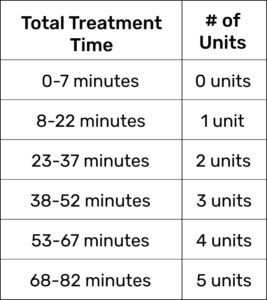
Introduction
It might seem like a minor detail, but visit durations play a significant role in running an outpatient treatment clinic. The methodology that you use to schedule visits within your practice can have a dramatic impact on how many patients you can treat in a week, how hands-on you are with those patients, your therapist’s overall levels of stress, and much more.
When you are working to prepare a budget and revenue estimation for your clinic, you must consider how long your average visits are to properly forecast potential revenue. And when considering the visit duration, you need to consider your individual patients, their desire for treatment, and the complexity of their cases – not to mention your therapists’ preferred treatment methodologies. In other words, you shouldn’t just copy and paste schedule blocks and call it a day!
This blog is going to analyze how different visit durations impact the total number of visits and potential units you can bill in a given calendar week per therapist. In this analysis, we will focus on a clinic that operates in the CMS Medicare 8-minute rule world; before using this analysis, we recommend you check to see what portion of your payers allow you to bill using the AMA Billing Rules. For purposes of this analysis, we are going to consider that a therapist only treats one patient at a time. You can learn more about the two different 8-minute rules here.
Medicare 8-Minute Rule
The Medicare 8-minute rule is a standard practice in the PT industry for analyzing the total billable treatment time (i.e. hands-on time) with a patient in a given visit, and allows you to bill a total number of units based on that total treatment time. The following table shows the number of billable units you can expect based on the length of an individual patient visit.
Analyzing four visit duration options
Ultimately, the duration you choose to schedule your visits for will have a major impact on how many units you can bill for each visit that you treat. The table below analyzes how many total visits and total units you would expect to bill for a given week per provider. For purposes of this analysis, we assume that one therapist has 35 hours of total treatment time available per week (an 8-hour work day with an estimated 1 hour of lunch time and other meetings per day).
Based on the four example visit durations above, a 40-minute average visit duration maximizes the total potential billable units in a week for a provider. However, as mentioned above, you must carefully consider all factors when planning out your treatment schedule and how long you will treat patients for on a given visit.
Schedule variables
Beyond the numbers, your team will always have to account for other factors in how your schedule plays out, and be ready to adjust as you go. For instance, a clinic may have more or less new patient evaluations depending on the week. This can have a large impact on the overall schedule and the availability of treatment times.
In addition, your clinic may be so busy after completing a large number of evaluations, there may be patients on a waiting list for follow-up visits. Pair that with the unpredictability of patient cancellations and no-shows. In these cases, the right scheduling platform can help you fill any gaps as quickly as possible so you can hit your expected number of visits for the week.
Conclusion
A few minutes of difference adds up very quickly. Managing your rehab therapy practice is not just about the number of patients, but the types and lengths of each and every visit. You need to create a system that works – based on the industry rules, the treatments you provide, and your staff size and availability – and consider all possible factors when booking out your visits and determining their duration. That attention to detail here will go a long way for you, your team, and your patients.





